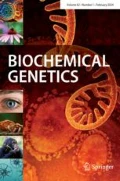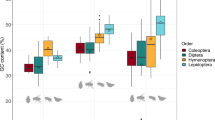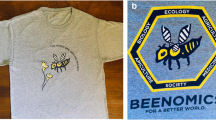Abstract
The tenebrionid beetles Tribolium castaneum and T. confusum are representative of two distinct species groups within their genus. It has been suggested [Smith, S. G. (1952). J. Morphol. 91:325] that the 8AA + neo-XY karyotype of T. confusum was derived from the ancestral 9AA + XY formula, still present in T. castaneum, via the fusion of one pair of autosomes with the X and Y chromosomes during the early divergence of the confusum and castaneum species groups. In the present paper, electrophoretic variation in malic enzyme and hexokinase-1, detected in laboratory strains in Tribolium, is described. Evidence is presented that the genes encoding variation in both enzymes are autosomal in T. castaneum but are X linked in T. confusum. These species-specific patterns of inheritance of homologous gene loci are consistent with the hypothesized karyotypic history of the genus.
Similar content being viewed by others
References
Ayala, F. J. (ed.) (1976). Molecular Evolution Sinauer Associates, New York.
Daly, H. V., and Sokoloff, A. (1965). Labiopedia, a sex-linked mutant in Tribolium confusum Duval (Coleoptera: Tenebrionidae). J. Morphol. 117251.
Dawson, P. S. (1968). Genetic evidence for an hypothesis concerning evolution in Tribolium. J. Hered. 59188.
Dawson, P. S., and Hollingsworth, N. M. (1982). Sex linkage of the glucose 6-phosphate dehydrogenase locus in the flour beetle Tribolium castaneum. Can. J. Genet. Cytol. 24267–271.
Hinton, H. E. (1948). A synopsis of the genus Tribolium Macleay, with some remarks on the evolution of its species-groups (Coleoptera: Tenebrionidae). Bull. Entomol. Res. 3913.
King, M., and Wilson, A. C. (1975). Evolution on two levels in humans and chimpanzees. Science 188107.
Markert, C. L., Shaklee, J. B., and Whitt, G. S. (1975). Evolution of a gene. Science 189102.
Nei, M. (1972). Genetic distance between populations. Am. Natur. 106283.
Nei, M. (1978). Estimation of average heterozygosity and genetic distance from a small number of individuals. Genetics 89583.
Samollow, P. B. (1978). Dynamics of Enzyme Polymorphism in a Natural Population of the Boreal ToadPh.D. thesis, Oregon State University, Corvallis.
Sarich, V. M. (1977). Rates, sample sizes, and the neutrality hypothesis for electrophoresis in evolutionary studies. Nature 26524.
Schaal, B. A., and Anderson, W. W. (1974). An outline of techniques for starch gel electrophoresis of enzymes from the American oyster Crassostrea virginica Gmelin. Technical report of the Georgia Marine Science Center, p. 74–3.
Selander, R. K., Smith, M. H., Yang, S. Y., Johnson, W. E., and Gentry, J. B. (1971). Biochemical polymorphism and systematics in the genus Peromyscus. I. Variation in the old field mouse (Peromyscus polionotus). Stud. Genet. VI. Univ. Tex. Publ. 7103, p. 49.
Shaw, C. R., and Prasad, R. (1970). Starch gel electrophoresis of enzymes—a compilation of recipes. Biochem. Genet. 4297.
Smith, S. G. (1952a). The cytology of some Tenebrionid beetles (Coleoptera). J. Morphol. 91325.
Smith, S. G. (1952b). The evolution of heterochromatin in the genus Tribolium (Tenebrionidae: Coleoptera). Chromosoma 4585.
Smith, S. G. (1953). Chromosome numbers in Coleoptera. Heredity 731.
Smith, S. G. (1960). Chromosome numbers in Coleoptera. II. Can. J. Genet. Cytol. 266.
Smith, S. G. (1962). Cytogenetic pathways in beetle speciation. Can. Entomol. 94941.
Sokoloff, A. (1966). The Genetics of Tribolium and Related Species Academic Press, New York.
Sokoloff, A., Ackermann, M., and Overton, L. F. (1967). Linkage studies in Tribolium confusum Duval. II. The map position of three homeotic mutants. Can. J. Genet. Cytol. 9490.
White, M. J. D. (1973). Animal Cytology and Evolution Cambridge University Press, London.
White, M. J. D. (1977). Modes of Speciation W. H. Freeman, San Francisco.
Wool, D. (1982). Critical examination of postulated cladistic relationships among species of flour beetles (Genus Tribolium, Tenebrionidae, Coleoptera). Biochem. Genet. 20333.
Author information
Authors and Affiliations
Additional information
This work was supported by national Science Foundation Grant DEB 77-25569 to RAR.
Rights and permissions
About this article
Cite this article
Samollow, P.B., Dawson, P.S. & Riddle, R.A. X-linked and autosomal inheritance patterns of homologous genes in two species of Tribolium . Biochem Genet 21, 167–176 (1983). https://doi.org/10.1007/BF00498908
Received:
Revised:
Issue Date:
DOI: https://doi.org/10.1007/BF00498908




